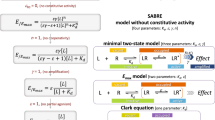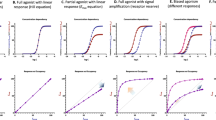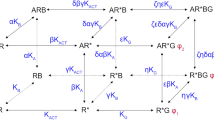Abstract
ONE of the cornerstones of all quantitative applications of classical receptor theory has been the postulate that the response of a given organ or tissue is proportional to the number of receptors occupied by the activating agent, and that the maximal response occurs when all receptors are occupied. Although never proved experimentally, and perhaps a priori somewhat unlikely in view of the complex nature of tissue responses, this relationship is necessary if agonist dose – response curves are to be explained in terms of mass-action equilibria, and it provides the basis for differentiating reversible competitive from non-competitive or irreversible inhibition. Basic formulations applying mass-action considerations to the differentiation of types of inhibition are those of Gaddum1, applied largely to tissue and organ responses, and of Linweaver and Burke2, which have been applied both to relatively simple enzyme systems and to complex responses of tissues and of intact animals.
This is a preview of subscription content, access via your institution
Access options
Subscribe to this journal
Receive 51 print issues and online access
$199.00 per year
only $3.90 per issue
Buy this article
- Purchase on Springer Link
- Instant access to full article PDF
Prices may be subject to local taxes which are calculated during checkout
Similar content being viewed by others
References
Gaddum, J. H., J. Physiol., 89, 7P (1937).
Linweaver, H., and Burke, D., J. Amer. Chem. Soc., 56, 658 (1934).
Chen, G., and Russell, D., Arch. Int. Pharmacodyn., 84, 176 (1950). Chen, G., and Russell, D., J. Pharmacol. and Exp. Therap., 99, 401 (1950). Graham, J. D. P., and Lewis, G. P., Brit. J. Pharmacol., 8, 54 (1953).
Nickerson, M., Pharmacol. Rev., 1, 27 (1949).
Similar shifts of adrenaline and histamine dose–response curves have been reported to occur after exposure of tissues to dibenamine and SY-28 (N-1-naphthylmethyl-N-ethyl-β-bromoethylamine); see Furchgott, R. F., Pharmacol. Rev., 7, 183 (1955).
Author information
Authors and Affiliations
Rights and permissions
About this article
Cite this article
NICKERSON, M. Receptor Occupancy and Tissue Response. Nature 178, 697–698 (1956). https://doi.org/10.1038/178697b0
Issue Date:
DOI: https://doi.org/10.1038/178697b0
This article is cited by
-
Coupling mode of receptors and G proteins
Naunyn-Schmiedeberg's Archives of Pharmacology (2009)
-
Myocardial performance in conscious streptozotocin diabetic rats
Cardiovascular Diabetology (2006)
-
Pharmacological characterization of a 7‐benzylidenenaltrexone‐preferring opioid receptor in porcine ileal submucosa
British Journal of Pharmacology (2003)
-
Risk assessment of adverse pulmonary effects induced by adrenaline β-receptor antagonists and rational drug dosage regimen based on receptor occupancy
Journal of Pharmacokinetics and Biopharmaceutics (1995)
Comments
By submitting a comment you agree to abide by our Terms and Community Guidelines. If you find something abusive or that does not comply with our terms or guidelines please flag it as inappropriate.



